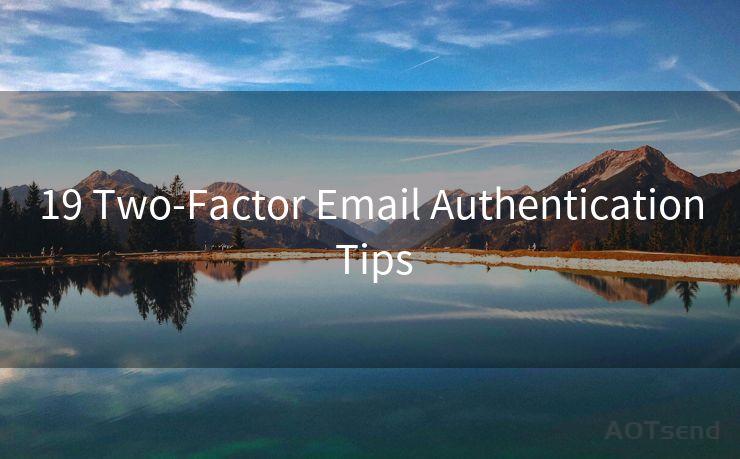19 Two-Factor Email Authentication Tips




In the digital age, email security is paramount. Two-factor authentication (2FA) adds an extra layer of protection to your email account, making it more difficult for unauthorized individuals to access your sensitive information. Here are 19 tips to help you make the most of two-factor email authentication for enhanced security.
1. Understand Two-Factor Authentication
Two-factor authentication combines two different verification methods: something you know (like a password) and something you have (like a smartphone or a hardware token). This dual verification process significantly reduces the risk of unauthorized access.
2. Enable 2FA on Your Email Account
Most major email providers, such as Gmail, Outlook, and Yahoo, offer two-factor authentication. Make sure to enable this feature in your account settings.
🔔🔔🔔
【AOTsend Email API】:AOTsend is a Managed Email Service for sending transactional emails. Support Email Types: reminders, authentication, confirmations, notifications, verification codes, invoices, password resets, account activations, billing statements, two-factor authentication (2FA), and one-time passwords (OTP) emails, etc. $0.28 per 1000 Emails. 99% Delivery, 98% Inbox Rate.
You might be interested in:
Why did we start the AOTsend project, Brand Story?
What is a Managed Email API, How it Works?
Best 25+ Email Marketing Platforms (Authority,Keywords&Traffic Comparison)
Best 24+ Email Marketing Service (Price, Pros&Cons Comparison)
Email APIs vs SMTP: How they Works, Any Difference?
3. Use a Strong Password
Your password is the first line of defense. Create a unique and complex password that includes a mix of uppercase letters, lowercase letters, numbers, and symbols.
4. Keep Your Mobile Device Secure
Since your mobile device is often used as the second factor in 2FA, it's crucial to keep it secure. Use a strong PIN or password to lock your device and consider encrypting your data.

5. Backup Your 2FA Codes
If you lose access to your primary 2FA method, having backup codes can be a lifesaver. Make sure to store these codes securely and in a place where you can easily retrieve them if needed.
6. Update Your Software Regularly
Keeping your email client, operating system, and any related software up to date is essential for maintaining security. Regular updates often include critical security patches.
7. Beware of Phishing Attacks
Phishing attacks try to trick users into revealing sensitive information, including 2FA codes. Never share your 2FA codes with anyone, and be cautious of any emails asking for personal information.
8. Use a Trusted 2FA App
When using a mobile app as your second factor, choose one that is well-reviewed and trusted by the security community.
9. Consider a Hardware Token
For even stronger security, consider using a hardware token like a Yubikey. These physical devices provide an additional level of authentication that is difficult to hack.
10. Don't Reuse Passwords
Using the same password for multiple accounts increases the risk of a breach. If one account is compromised, others may be at risk. Use a unique password for each account.
11. Monitor Your Account Activity
Regularly check your email account's activity log to ensure there are no unauthorized access attempts.
12. Enable HTTPS
Always access your email account over a secure HTTPS connection to ensure that your data is encrypted while in transit.
13. Be Cautious of Public Wi-Fi
When accessing your email on public Wi-Fi, use a VPN to encrypt your connection and reduce the risk of eavesdropping.
14. Educate Yourself on Security Threats
Stay informed about the latest security threats and how to protect yourself. Knowledge is power when it comes to online security.
15. Consider Using an Alias Email Address
For services that don't require your primary email address, consider using an alias email address to further protect your identity.
16. Backup Your Data Regularly
In case of a security incident, having a recent backup of your data can be invaluable. Make sure to backup your email and other important data regularly.
17. Use a Password Manager
A password manager can help you create, store, and manage complex passwords for all your accounts, including your email.
18. Disable Access for Less Secure Apps
If your email provider offers this option, disable access for less secure apps to reduce the risk of unauthorized access.
19. Stay Vigilant
Online security is an ongoing effort. Stay vigilant and proactive in protecting your email account and personal information.
By following these 19 two-factor email authentication tips, you can significantly enhance the security of your email account and reduce the risk of unauthorized access. Remember, security is a shared responsibility, and staying informed and proactive is key to protecting your digital identity.




Scan the QR code to access on your mobile device.
Copyright notice: This article is published by AotSend. Reproduction requires attribution.
Article Link:https://www.mailwot.com/p7199.html



